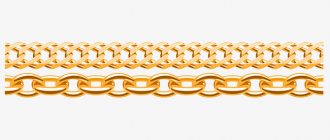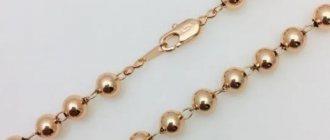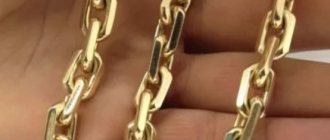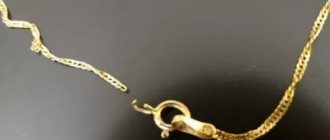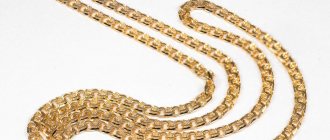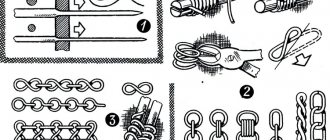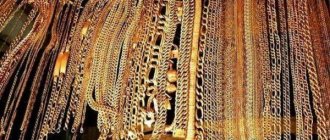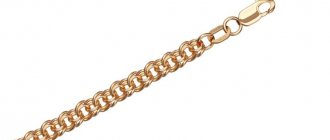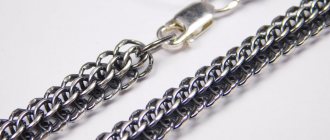January 28, 2022 Silver and gold chains are one of the most popular jewelry pieces on the market. They are worn around the neck separately, together with pendants or Orthodox crosses, but almost always the chain attracts attention first - with its shine and intricate weaving.
It is the pattern technique that creates this unique effect, when tiny pieces of precious metal wire are transformed into a work of art filled with images.
Let's look at which chain weaving is the strongest, what techniques there are, how they differ from each other, and who should choose this or that style of presentable jewelry.
A little about weaving technology
The Double Diamond is woven both by machine and by hand, but using a wide range of special equipment. The links are made of wire or cut from a blank, inserted into each other and sealed.
Then the product goes under the press, where the links take on a characteristic shape, turning at the desired angle. At the finish line, even a chain woven by a machine falls into the hands of a craftsman, who fine-tunes the product, decorates it with the specified decorative additions, and equips it with a lock.
Nonna's weaving is visually very similar to Double Rhombeau. However, they use diamond-shaped links of different sizes, which gives rise to a bizarre openwork pattern.
Jewelry stores mainly receive Double Rhombo chains, machine-made from 585 gold, silver of two highest grades for the industry, as well as silver items with gilding.
Weaving chain “Nona”
Chain weaving "Double diamond"
Both solid and hollow gold wire can be used. The second option is relevant for externally massive gold items, mainly men's neck chains and bracelets. This is done in order to reduce the consumption of precious metal and, accordingly, the cost of jewelry. However, “blown” jewelry is significantly inferior to solid jewelry in terms of strength.
Despite the apparent simplicity of the technology, the result is exquisite jewelry for all tastes. Various jewelry is made using this technique: from massive and status men's chains and bracelets to elegant women's gold chains: The double rhombus is surprisingly versatile.
Interestingly, a chain of this type can be exquisitely elegant in itself, especially if some special technology for processing the links is used (for example, diamond cutting). The decoration can be enlivened by some additions, inserts of a different weave, or be a composition of two different-colored metals (for example, yellow and white gold). The imagination of jewelers is limitless!
Almost any Double Diamond goes well with pendants: from luxurious pendants with stones to laconic crosses and amulet. The only exceptions are the most massive chains.
Types of weaving
There are many varieties of weaving within the Double Diamond, but the most popular are:
- Standard Double Diamond. The links have the shape of an elongated rhombus. The result is elegant, seemingly flowing products.
- Inverted square. The links resemble squares placed on the corner. An excellent option for massive men's jewelry.
- Rounded corners. Each link is a cross between a diamond and an oval, creating chains that resemble flower wreaths.
The appearance of the product depends not only on the shape of the links, but also on their size, the thickness of the edges, the presence of inserts, and final processing. The angle of rotation of the links also plays an important role. It determines the density of the weaving: from practically knitted to airy openwork. The greater the angle of inclination, the more “lacey” the decoration looks.
Types of chain weaving
There is much more variety here, because over the centuries-old tradition of jewelry making, dozens of ways have been invented to weave ordinary metal wire into an intricate pattern.
Many styles are combined into two conditional groups - anchor and shell weaving, each of which is unique and aesthetically pleasing in its own way. They are used separately or combined with each other, turning an ordinary chain into a masterpiece of painstaking work by a master.
Anchor weaving got its name from the navy. The same ship chains that hold huge ships on the high seas inspired jewelers back in ancient times, when the first smaller analogues were created in the form of jewelry made of gold and silver. The technology is relatively simple, practical, and is still successfully used in the production of budget and premium class jewelry.
Popular anchor weave styles:
- Bril, also known as rollo, is the most popular and easiest to perform technique, when oval-shaped links are fastened together one at a time. They can be round or flattened (rollo-trampoline) along the entire length of the chain. The original option is additional diamond processing of the edges.
- Korda is a more complicated version of bril, which recreates the recognizable silhouette of a twisted ship's rope. Instead of one, three elements are used here, connecting them not directly, but “in steps.” This creates the effect of knots; it looks aesthetically pleasing on a man, and with a suitable pendant or pendant, on a woman.
- Garibaldi is a weaving technique with a romantic history. It is believed that it received its name in honor of the Italian revolutionary Giuseppe Garibaldi and his last wife. That is why the style uses a paired connection of two links from the inside and outside, creating the impression of a powerful inextricable union.
- Tondo is another basic style that comes from Italy. In the Renaissance, this word was used to describe panels or lampshades, where artists painted the image of the Madonna surrounded by angels. Such paintings were almost always round in shape, which was carried over into jewelry - perfectly round links without pressing or diamond cutting.
Armor weaving is much more varied in style and is not related to the animal world. Its name goes back to medieval chain mail armor, which is still usually referred to as “shell” in historical sources. The links here are located at an angle and in a single plane, which gives maximum fit to each other, strong couplings, comfortable wearing and virtually unlimited possibilities for combining shapes and sizes.
Types of armor weaving:
- The double diamond is perhaps the most famous among armored forms, when each link is made in the form of an equilateral geometric figure. A specific grip ensures strong fastening, and diamond-cut processing increases wearing comfort - the product does not bite the skin or cling to the fabric of clothing.
- Nonna is an elegant version of a diamond, but with slightly rounded links. A recognizable feature of weaving has become elements of different diameters, and traditionally - one inside the other. For such an openwork silhouette, Nonna is considered an ideal women's style, although it is increasingly being combined with massive men's pendants or crosses.
- Singapore is one of the most popular twisted weaves, named after East Asian national patterns. The diamonds here are slightly curved in two planes, creating visually beautiful “curls,” and the additional processing of the edges has become a godsend for a unique “playful” reflection in the light.
- Love is an original technique in which the links resemble two mirrored numbers 9, which when connected give a “heart” shape. Despite the romantic (if not sentimental) message of the image, the fixation in this style is much stronger than that of a double diamond due to the three points that hold each element.
- Snake is an avant-garde weaving style invented in the second half of the 20th century. The rings in it are collected into a smooth “cord” that looks like snake skin. The cross-section can be round, as well as strictly square or rectangular. The name Montreal is also found - for flattened flat “snakes”.
- Python - aka Italian. A “pumped up” version of a double diamond, or rather a triple one, in which the links have slightly rounded edges with pronounced diamond processing. The trademark, thanks to which Python cannot be confused with anything, is the arrangement of elements at different angles to each other, without parallel lines.
- Byzantium - in another way, Kolos or Fox's Tail. A complex weaving technique that requires great skill of a jeweler and the finest handwork. The style is inspired by medieval engravings, which used patterns with pointed “arrows”, although rounded, strongly curved links are also often used.
Separately, manufacturers highlight Bismarck weaving, which has become synonymous with men's style in chains. It is somewhat reminiscent of Python, with the only difference being that the links have different directions and angles of inclination, visually adding massiveness to the relatively light weight of the decoration. Bismarck braids both hollow and solid chains, each time surprising with the possibilities of combinations in the type of fixation or the shape of the rings.
Among the weavings visually related to Bismarck, it is worth mentioning the Cardinal style - it is something between Python and Byzantium, but due to its complexity, the technique has not gained much popularity. Cartier - also classified as armored, here the links differ in length - elongated ones alternate with round ones.
Benefits of weaving
The undeniable advantages of Double and Triple Diamond include:
- Premium durability. As mentioned above, Double and Triple Diamonds are recognized leaders in terms of strength. It is almost impossible to accidentally break a high-quality chain of such weaving.
- Versatility. Double Rhombo is a time-tested classic that suits absolutely everyone, regardless of gender, age, occupation or favorite style of clothing.
- Compatibility. A chain woven in this way is decorative in itself, but it never minds making friends with pendants. Moreover, thanks to its laconic design, it looks advantageous both with a pendant made in a futuristic angular-geometric manner, and with a pendant with stones in a vintage or ethnic style.
If you are choosing a chain as a gift, there is no better option than the Double or Triple Rhombo - this decoration will suit absolutely everyone!
28.02.21
Triple diamond
Triple diamond weaving is the joining of three links into one and their subsequent arrangement, as in the case of double weaving. This decoration is highly durable and is not at all afraid of mechanical damage. In the vast majority of cases, 585-carat gold and other types of precious metals (iridium, platinum, californium) are used for a diamond-shaped pattern using the triple weaving method. This weaving method is considered complex, and therefore jewelry using it is rare and expensive.
The double diamond is much more common. It looks equally impressive on women and men of any age. The flat yet weighty design lays comfortably on skin or clothing without twisting. This weave never goes out of style .
